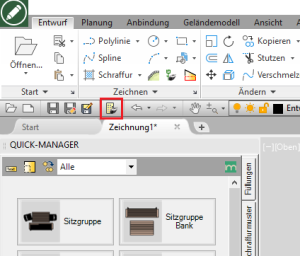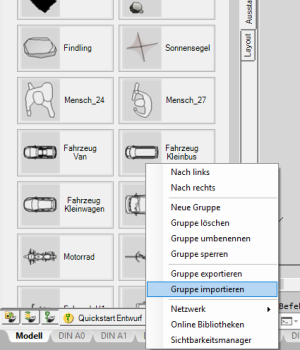Table of Contents
Quick manager
Command: DFQUICK
Description
The Quick manager enables drawing objects to be captured (see Quick-Masses), editing the layer structure (see Quick layer) and the use and management of library elements (hatches, images and blocks).
Library elements with a lock shown at the bottom right of the preview image are encrypted and protected elements.
Application
Insert picture or block
- Click with the left mouse button on an icon within the Range and hold down the mouse button.
- Drag the mouse pointer to the drawing area and release the mouse button.
- Pick the first insertion point.
- Drag the pointer diagonally. Click the left mouse button when the desired size is visible or enter the desired size using the keyboard.
- Add more objects into the drawing by clicking the respective insertion point in the drawing.
- Finish inserting objects with the Enter Button.
Insert hatching
- Click with the left mouse button on a symbol within the palette and keep the mouse button pressed.
- Drag the mouse pointer to the drawing area and release the mouse button.
- Select the object or objects to hatch.
- Confirm your selection with Enter Button.
You can also access the elements from the library directly on the folders or on the objects already recorded in the window Quick-Masses pull. The objects then receive the selected graphic assignment.
Push block into pallets
- Create the desired drawing element, e.g. a parasol, as a block (see also Tips and Tricks > Create block).
- First select the block and then use the left mouse button to move it into the desired palette.
- The block appears in the palette.
Sometimes the block does not appear in the palette. To avoid this, choose the command BLOCK ICON with the option * before the block is to be moved to the desired palette.
Dynamic blocks
With the pallet Dynamic blocks from the Online library (see below), drawing objects with a lot of additional information are available to you. Instead of drawing them again and again, fit them into the drawing after inserting them (see above Insert picture or block) only reflect the dimensions of the current situation.
Floor plans, views and sections are available depending on the element. Many drawing objects are already provided with technical details and standard dimensions. If changes are made, all elements are updated in one step. The library contains around 100 items on various topics.
In the area Structural Engineering you will find many objects that occur every day such as fences, gates, garages, stairs, barrier-free ramps and cable ducts.
Within the Drainage planning there are, for example, manhole structures, infiltration structures and road gullies. The shaft structures are inserted complete with base plates, compensation rings and cover.
On the subject Sports field planning all regularly required drawing elements are available, from soccer fields to special elements such as triple jump and discus throwing systems.
The area Planning and layout Contains height markers, ramp arrows, stair arrows, standard sections and various planning aids. With the referenced height dimensions, height gradients can be displayed and changed very easily. The slope aid enables you to insert several elements with a specified slope, e.g. high curbs or angle supports. The plan header template, font sizes for different scales and folding marks for DIN sizes A4 to A0 help with the print-ready preparation of the plan.
Features
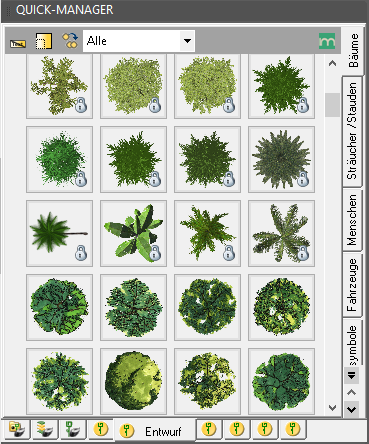
 | Show text: Displays the symbols with or without text. |
 | Image size: Displays small or large icons. |
 | different: Inserts the selected object multiple times or individually into the drawing. |
 | Choice of whether All Objects of a Range or only Hatching, pictures, blocks, symbol lines or Landscape objects should be displayed. |
 | Opens the mtextur browser. The selected textures (also multiple selection via Ctrl or Shift possible) can be dragged and dropped into the selected palette of the libraries. |
The window Quick manager can you like the window Features Position or fix in the work area.
Pallet groups
In the lower part of the window you can choose between Quick-Masses, Quick layer, Quick graphics and the existing groups of the library can be switched.
Right-click below on a palette group (e.g. Quickstart Design). With the functions Nach links and Nach rechts the order of the groups can be sorted. Here you can get one new group add a Rename group, a Group delete and Lock group.
You can also use all of the pallets Export group and on another computer again the Import group.
Go to the Import a group choose the one you want XML file (e.g. Dynamic Blocks_PageExport.xml) in your directory. The new group (e.g. dynamic blocks) is created with the palettes it contains.
Once you get one Specify the network path, you have the option to access your libraries on the Network zu copy or to move. The library folders are shown in italics when you transfer them from the network to your workstation. With the option Lock group as the PasswordInput, it can be guaranteed that the objects contained in the libraries cannot be changed or deleted. Should changes be made, this can be done using the option Unlock group respectively.
Online library
In the DATAflor Online libraries you will find extensive libraries that you can search for [Import] within DATAflor Be able to use CAD. Customers with a maintenance contract will find many other available elements in the CAD Lounge.
With the Visibility manager Entire libraries or individual palettes can be hidden and shown again, given a color and an individual symbol by clicking on the corresponding area (sun / snowflake, color area, symbol). These settings can be reset at any time.
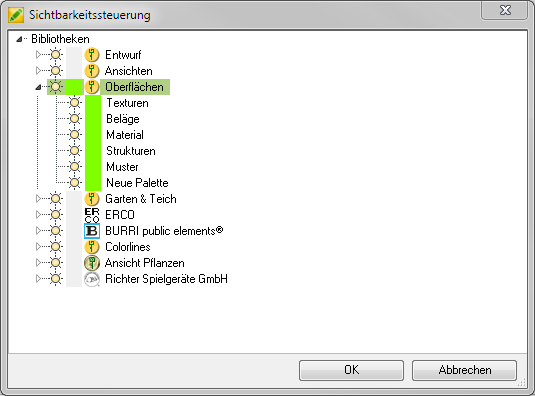
Pallets
On the right side of the window are the Palletswhich also enable further functions via the right mouse button: New pallet, pallet delete, Rename palette.
With the functions Up and Cable hanging down the order of the pallets can be sorted.
Individual pallets can also be used the exportier and on another computer again import.
Additional functions are available for the individual objects in the library (hatches, images and blocks). If you right-click an icon, you can view the object Delete, Rename, copywhich Update tool image (Icon is updated automatically) and another one Specify picture (select the desired image for the symbol).
With the function exchange in drawing both images and blocks can be replaced with others. To do this, then select the images / blocks in the drawing that are replaced by the current Object should be replaced.
If images / blocks have already been selected in the drawing, they will be used directly when the function is selected exchange in drawing replaced.
Customize properties
In the Features Object-specific parameters can be defined using the symbol.
You can multiple objects in the library and thus adapt useful properties at the same time. To do this, hold down the button while selecting Shift or Ctrl pressed.
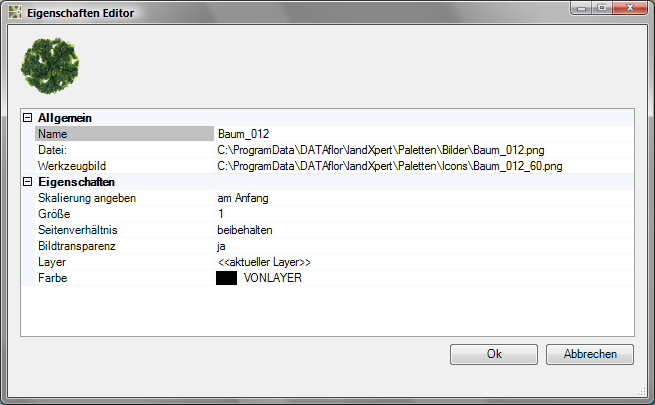
In the case of images and blocks, the property is particularly important Specify scaling Interesting. This determines how the scaling takes place. Standard is at the beginning, the scaling only queried before the first picture and adopted for all further pictures until the command with the Enter Button is completed. At all individually the scaling is requested for each image. At Fixed factor the scaling is not queried, but the value from the property for all images Size .
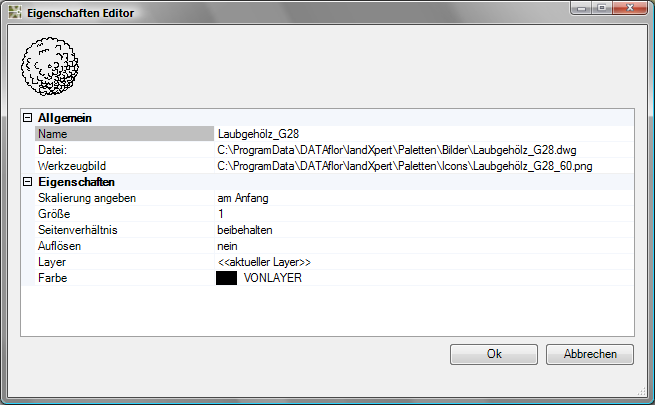
The property Dissolve for blocks defines how the object is inserted into the drawing: as Block or resolved into its sub-objects (lines).
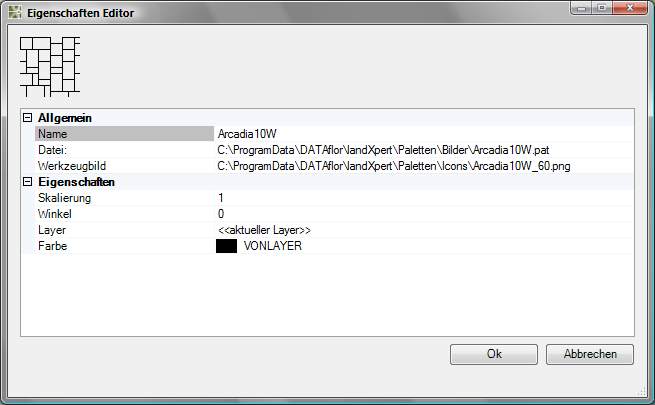
The property Shop consider Hatching Specifies a relative angle for the hatch pattern to the X-axis of the current user coordinate system.
Assign plants and materials
It is possible to add objects (pictures and blocks) in Quick manager assign a plant and / or a material, for example about the Object manager to receive a list of plants or materials.
If the object is inserted into a drawing, an entry is automatically made in the Object manager created. This entry consists of the storage location of the object in Quick manager and contains the number of objects inserted.
So you can click and drag from the Quick Manager to create a material or plant plan.
- Right-click on the corresponding symbol and select the entry from the context menu Features.
- In the window Features are located under Other two entries: material and plant.
- First click on the entry Unallocated and then on the button [...].
- The opens Material- or Plant editor.
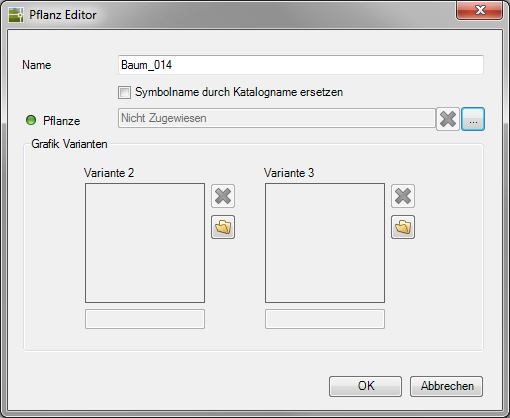
- In the dialog you can assign a new name for the object or replace the name with the catalog name of the material or the plant.
Click the button [...] , to select a material or a plant from the installed material / plant catalogs and assign it to the object.
Instruct the plants Quality to, this is used automatically when inserting. If no quality has been selected, you will be asked which quality should be used when inserting the plant.
You can also assign graphic variants 2 and 3. These are automatically saved in Object manager entered as graphic variants.
- Confirm your entries with [OK].
- Also close the properties editor [OK].
The preview image in Quick manager is now provided with a symbol at the top right. This symbol shows you whether a material  , a plant
, a plant  or material and plant
or material and plant  assigned to the object.
assigned to the object.

